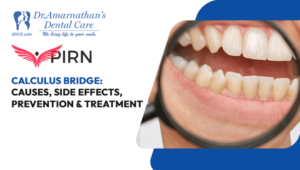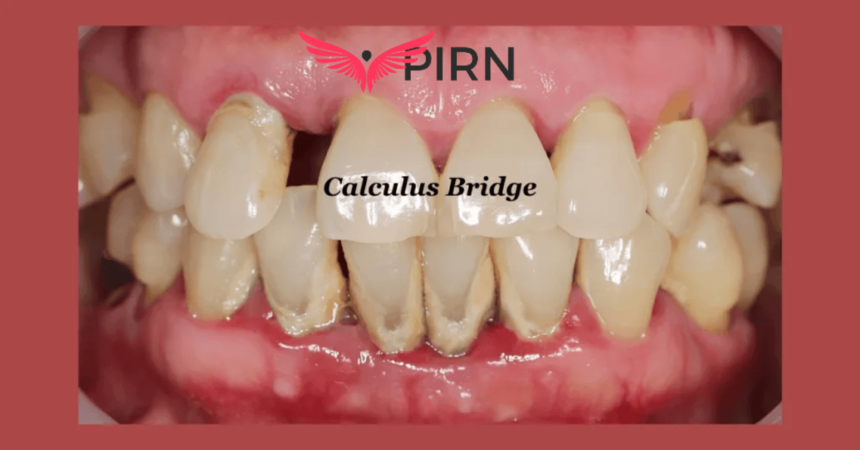Introduction
Calculus bridge is a dental condition that occurs when plaque hardens on the teeth and forms a thick, visible layer of tartar, commonly covering multiple teeth in a continuous, bridge-like structure. This buildup is more than just a cosmetic issue; it can lead to serious dental problems if left untreated. In this article, we will explore what calculus bridge is, its causes, symptoms, and how it can be treated. We will also discuss preventive tips to avoid calculus bridge formation and improve overall oral hygiene. Understanding calculus bridge is essential for anyone who wants to maintain healthy teeth and gums and avoid common dental issues.
What is Calculus Bridge?
Calculus bridge, also known as tartar bridge, refers to a thick, hardened layer of plaque and tartar that accumulates on the teeth, especially near the gum line. When plaque – a soft, sticky film of bacteria – is not removed regularly, it hardens into calculus (tartar). Over time, this buildup can become extensive, forming a “bridge” that spans across multiple teeth. Calculus bridge is not only unsightly but also poses risks to oral health by increasing the chances of gum disease, tooth decay, and other dental issues.
Causes of Calculus Bridge
There are several causes of calculus bridge, most of which relate to inadequate oral hygiene and certain lifestyle factors. Here are some of the main reasons calculus bridge develops:
1. Poor Oral Hygiene
One of the primary causes of calculus bridge is poor oral hygiene. If teeth are not brushed and flossed regularly, plaque remains on the surface, allowing it to harden into calculus over time.
2. High Sugar and Starch Diet
Consuming a diet high in sugars and starches can contribute to plaque formation. Sugars feed the bacteria in the mouth, leading to the buildup of plaque, which eventually hardens into calculus.
3. Smoking and Tobacco Use
Smoking and using tobacco products can accelerate the formation of calculus. Tobacco not only stains teeth but also makes it easier for plaque to harden into calculus.
4. Dry Mouth
Saliva helps wash away food particles and neutralize acids produced by bacteria in the mouth. People with dry mouth have less saliva, increasing the risk of plaque and calculus buildup.
5. Misaligned Teeth
Crowded or misaligned teeth can create areas that are harder to clean, making it easier for plaque to build up and turn into calculus, leading to calculus bridge formation.
Symptoms of Calculus Bridge
Identifying the symptoms of a calculus bridge can help you take action before the buildup worsens. Here are some common signs of calculus bridge:
1. Visible Tartar
The most noticeable symptom of calculus bridge is the visible presence of thick, yellowish or brownish tartar on the teeth, typically along the gum line.
2. Bad Breath
Calculus harbors bacteria, which can cause bad breath. If you experience persistent bad breath despite brushing and flossing, calculus buildup could be the cause.
3. Gum Inflammation and Bleeding
When calculus builds up along the gum line, it irritates the gums, leading to redness, swelling, and bleeding during brushing or flossing.
4. Gum Recession
In severe cases, calculus bridge can cause gums to pull away from the teeth, resulting in gum recession. This can expose the tooth root, making it more vulnerable to decay and sensitivity.
5. Tooth Sensitivity
As the gums recede and expose the roots of the teeth, you may experience increased sensitivity to hot, cold, or sweet foods and beverages.
How is Calculus Bridge Diagnosed?
To diagnose a calculus bridge, a dentist will typically perform a physical examination of your mouth, looking for visible signs of tartar buildup. They may also use a dental scaler to probe the teeth and gums, assessing the extent of the buildup. In some cases, X-rays may be taken to evaluate any underlying bone loss or periodontal issues caused by the calculus_bridge.
Treatment Options for Calculus Bridge
Treating a calculus_bridge is essential to prevent further oral health complications. Here are some effective treatment methods for calculus_bridge:
1. Professional Dental Cleaning
The most common treatment for calculus_bridge is professional dental cleaning, also known as scaling. During this procedure, a dentist or dental hygienist uses special tools to remove the hardened calculus from the teeth and gum line.
2. Scaling and Root Planing
For severe cases of calculus_bridge, scaling and root planing may be recommended. This is a deep cleaning procedure that not only removes tartar from above the gum line but also smooths the roots of the teeth to prevent bacteria buildup.
3. Ultrasonic Scaling
Some dentists use ultrasonic scaling devices that use high-frequency vibrations to break up and remove calculus. This method can be less painful and more effective for removing heavy buildup.
4. Laser Treatment
Laser treatment is a newer, minimally invasive option that can be effective in treating calculus_bridge. The laser targets and removes calculus without harming the surrounding gum tissue.
5. Periodontal Therapy
If calculus_bridges has led to periodontal disease, more extensive periodontal therapy may be necessary. This can include procedures to treat gum infection and support gum health.
Preventing Calculus Bridge
While calculus_bridges can be treated, prevention is always better than cure. Here are some ways to prevent calculus_bridges from forming:
1. Brush Twice a Day
Regular brushing, especially with a toothbrush designed to reach tight spaces, helps remove plaque before it hardens into calculus. Be sure to brush for at least two minutes, focusing on all areas of the mouth.
2. Use Fluoride Toothpaste
Using fluoride toothpaste can strengthen enamel and make it more resistant to plaque and tartar buildup, reducing the risk of calculus_bridges formation.
3. Floss Daily
Flossing removes food particles and plaque between the teeth where a toothbrush cannot reach. Daily flossing is crucial to prevent the buildup of calculus.
4. Rinse with Mouthwash
An antibacterial mouthwash can help reduce the bacteria in the mouth, preventing plaque from forming on the teeth and gums.
5. Visit the Dentist Regularly
Regular dental check-ups and professional cleanings are essential for preventing calculus_bridges. A dentist can remove any plaque or tartar before it accumulates into a thick layer.
6. Limit Sugary and Starchy Foods
Since sugar fuels bacterial growth in the mouth, limiting sugary and starchy foods can reduce plaque buildup and lower the risk of calculus_bridges.
7. Stay Hydrated
Drinking water helps keep the mouth moist and supports saliva production, which naturally cleans the teeth and reduces plaque formation.

FAQs about Calculus Bridge
Q1: What is a calculus_bridges made of?
A calculus_bridges is made of hardened plaque, or tartar, which is formed when bacteria and food particles accumulate on the teeth and are not removed through brushing and flossing.
Q2: Is calculus_bridges harmful?
Yes, a calculus_bridges can be harmful as it can lead to gum disease, tooth decay, gum recession, and bad breath if not treated.
Q3: Can I remove a calculus_bridges at home?
No, calculus_bridges cannot be removed at home. Professional dental cleaning is required to safely remove hardened tartar.
Q4: How often should I visit the dentist to prevent calculus_bridges?
It’s recommended to visit the dentist every six months for a routine cleaning to prevent calculus buildup and detect any early signs of calculus_bridges.
Q5: Can a calculus_bridges cause tooth loss?
In severe cases, untreated calculus_bridges can lead to periodontal disease, which may cause tooth loss if the underlying structures supporting the teeth become damaged.
Q6: Does laser treatment hurt when removing calculus_bridges?
Laser treatment for calculus_bridges removal is typically less painful than traditional methods, but some patients may experience minor discomfort.
Q7: Can children get calculus_bridges?
Children are less likely to develop calculus_bridges, but poor oral hygiene can lead to plaque and tartar buildup in young people as well.
Q8: Does diet affect the formation of calculus_bridges?
Yes, a diet high in sugars and starches can promote plaque formation, which can harden into calculus and lead to a calculus_bridges.
Q9: How can I tell if I have a calculus_bridges?
Visible tartar on the teeth, bad breath, gum inflammation, and bleeding are signs that may indicate the presence of a calculus_bridges.
Q10: Can electric toothbrushes help prevent calculus_bridges?
Yes, electric toothbrushes can be more effective at removing plaque, especially in hard-to-reach areas, helping prevent calculus_bridges formation.
Conclusion
Calculus_bridges is a common dental issue that can have serious consequences if left untreated. Formed by hardened plaque, a calculus_bridges can lead to gum disease, tooth decay, and other oral health problems. Recognizing the symptoms, such as visible tartar and gum inflammation, is key to seeking timely treatment. Professional dental cleaning, including scaling and root planing, is essential for removing a calculus_bridges. Practicing good oral hygiene, such as regular brushing, flossing, and routine dental visits, can prevent the formation of calculus_bridges and support a healthy smile.










